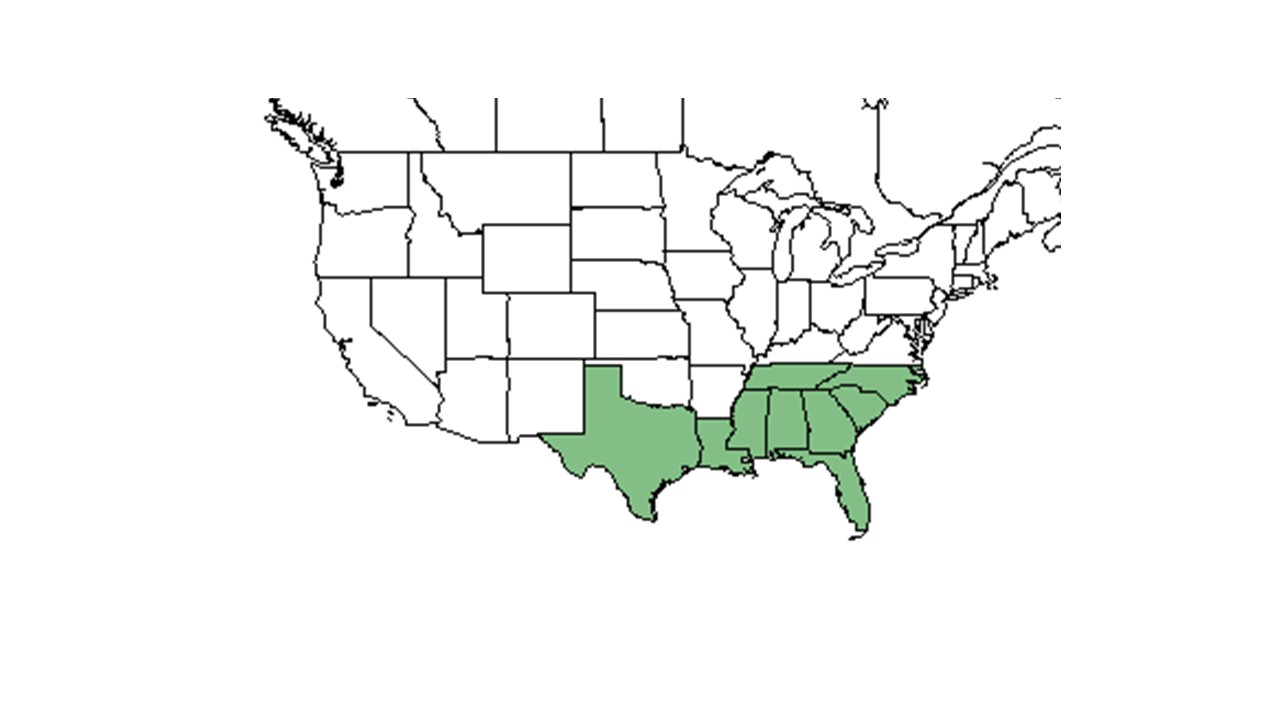Difference between revisions of "Rhynchosia reniformis"
KatieMccoy (talk | contribs) |
KatieMccoy (talk | contribs) (→Ecology) |
||
| Line 28: | Line 28: | ||
===Habitat=== <!--Natural communities, human disturbed habitats, topography, hydrology, soils, light, fire regime requirements for removal of competition, etc.--> | ===Habitat=== <!--Natural communities, human disturbed habitats, topography, hydrology, soils, light, fire regime requirements for removal of competition, etc.--> | ||
It is found in sandhills, savannas, dry woods, and roadsides (Nelson 2005). | It is found in sandhills, savannas, dry woods, and roadsides (Nelson 2005). | ||
| + | In the Coastal Plain region, ''R. reniformis'' can be found in burned longleaf pine-wiregrass stands, sandy open areas, loamy sands of longleaf pine-oak scrub open woodlands, sandpine flatwoods, recently burned scrubs of cutover pinewoods, burned upland lonleaf pine forest, pineflatwoods on limerock, and turkey oak sand ridges (FSU Herbarium). It can also be found in open powerlines, clobbered slash pine forests, fallow longleaf pine-scrub oaks, and railroad embankments. Associated species include ''Galactia mollis, Desmodium floridanum, Desmodium strictum, R. tomentosa, Pinus palustris, Aristida stricta'', slash pine, sand pine, ''Lactuca floridana, Serenoa repens,'' turkey oak, ''Acanthospermum, Polygala'' and ''Onosmodium'' (FSU Herbarium). | ||
===Phenology=== <!--Timing off flowering, fruiting, seed dispersal, and environmental triggers. Cite PanFlora website if appropriate: http://www.gilnelson.com/PanFlora/ --> | ===Phenology=== <!--Timing off flowering, fruiting, seed dispersal, and environmental triggers. Cite PanFlora website if appropriate: http://www.gilnelson.com/PanFlora/ --> | ||
It is inconsistently from April to September (Nelson 2005). | It is inconsistently from April to September (Nelson 2005). | ||
Revision as of 09:03, 6 October 2015
| Rhynchosia reniformis | |
|---|---|

| |
| Photo was taken by Gil Nelson | |
| Scientific classification | |
| Kingdom: | Plantae |
| Division: | Magnoliophyta - Flowering plants |
| Class: | Magnoliopsida - Dicotyledons |
| Order: | Fabales |
| Family: | Fabaceae |
| Genus: | Rhynchosia |
| Species: | R. reniformis |
| Binomial name | |
| Rhynchosia reniformis DC. | |

| |
| Natural range of Rhynchosia reniformis from USDA NRCS Plants Database. | |
Common name: Dollarleaf (Nelson 2005).
Contents
Taxonomic notes
Description
Distribution
Ecology
In a burning x no shade treatment, R. reniformis was found to have elevated levels of N2-fixation (Hiers and Mitchell 2007). Herbivory damage for R. reniformis does not increase with time since fire (Knight and Holt 2005).
Habitat
It is found in sandhills, savannas, dry woods, and roadsides (Nelson 2005). In the Coastal Plain region, R. reniformis can be found in burned longleaf pine-wiregrass stands, sandy open areas, loamy sands of longleaf pine-oak scrub open woodlands, sandpine flatwoods, recently burned scrubs of cutover pinewoods, burned upland lonleaf pine forest, pineflatwoods on limerock, and turkey oak sand ridges (FSU Herbarium). It can also be found in open powerlines, clobbered slash pine forests, fallow longleaf pine-scrub oaks, and railroad embankments. Associated species include Galactia mollis, Desmodium floridanum, Desmodium strictum, R. tomentosa, Pinus palustris, Aristida stricta, slash pine, sand pine, Lactuca floridana, Serenoa repens, turkey oak, Acanthospermum, Polygala and Onosmodium (FSU Herbarium).
Phenology
It is inconsistently from April to September (Nelson 2005).
Seed dispersal
Seed bank and germination
Fire ecology
R. reniformis is a legume found in frequently burned longleaf pine savannas (Brewer and Cralle 2003, Hiers and Mitchell 2007). It was observed to resprout one month after a fire in July of 1993 (Pavon 1995).
Pollination
Use by animals
Diseases and parasites
Conservation and Management
Cultivation and restoration
References and notes
- Brewer, J. S. and S. P. Cralle 2003. Phosphorus addition reduces invasion of a longleaf pine savanna (southeastern USA) by a non-indigenous grass (Imperata cylindrica). Plant Ecology 167: 237-245.
- Hiers, J. K. and R. J. Mitchell 2007. The influence of burning and light availability on N-2-fixation of native legumes in longleaf pine woodlands. Journal of the Torrey Botanical Society 134: 398-409.
- Knight, T. M. and R. D. Holt 2005. Fire generates spatial gradients in herbivory: an example from a Florida sandhill ecosystem. Ecology 86: 587-593.
- Nelson, Gil. East Gulf Coastal Plain. a Field Guide to the Wildflowers of the East Gulf Coastal Plain, including Southwest Georgia, Northwest Florida, Southern Alabama, Southern Mississippi, and Parts of Southeastern Louisiana. Guilford, CT: Falcon, 2005. 184. Print.